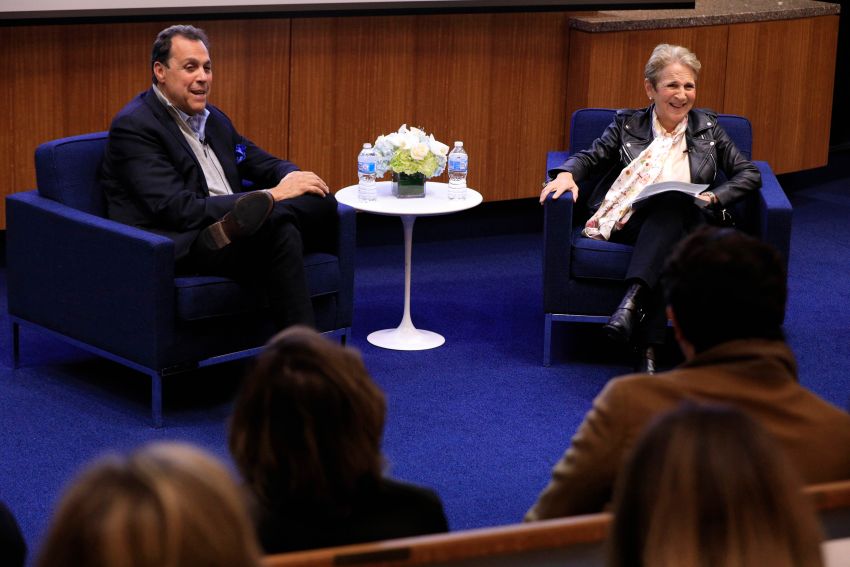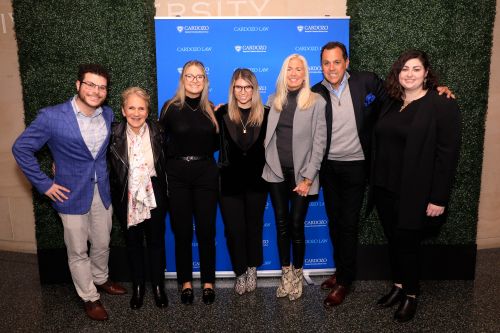
Designer Sam Edelman visited Cardozo to speak about the success behind his legendary shoe brands and his experience with fashion lawyers at FAME’s “Portrait of a Designer: An Evening with Sam Edelman” event. FAME Director and Cardozo Professor Barbara Kolsun ’82 interviewed Edelman about his career and journey to success.
Kolsun met Edelman when they both attended Sarah Lawrence College in the 1960s.
“I thought the village was the whole world,” Edelman said of his upbringing in New York City’s Greenwich Village. “I had to get really serious quickly.”
Edelman became fascinated with the sport and lifestyle of horses and jockeys. He remembered sitting in the bushes while watching horses. He created a “saddle room” that was fashioned according to the equestrian lifestyle. This caught the attention of Edelman’s first big connection to the fashion world: Ralph Lauren. Lauren hired Edelman to execute on his “saddle room” concept in Lauren's footwear, and at age 23, Edelman began traveling around Europe with Lauren and learning more about fashion and design.
Edelman advised new and young designers to take a similar approach in their careers and work for someone else first to get familiar with the business, then take what they learned to emerge on their own.
“I learned it from walking the streets of Europe,” Edelman said. “I was exposed to a very exciting group of artists and designers.” He reminisced about a family friend who made him a snakeskin jacket when he was 13 years old.
Kolsun asked about Edelman’s wife Libby, who Kolsun said that Edelman previously described Libby as his “muse” and as someone who was completely “agenda-less.” She noted that their marriage of 40 years was very unusual in their industry.
Edelman described his first meeting with Libby, when she was covering the shoe beat as a fashion editor at Seventeen. The two proved to be a successful business partnership as well, starting their own women’s shoe brand Sam & Libby. Kolsun asked how Edelman financed the brand before the days of private equity.
Edelman said it was his former fashion mentor Kenneth Cole who taught him about “factory financing”: a way of buying time by asking the factory to lend money while the shipment was processed.
“That’s how we financed Kenneth Cole, and that’s how we financed Sam Edelman,” Edelman said. “I’m a big believer that if you have a vision, factories will have to finance you.”
Edelman spoke of his early experiences with Kenneth Cole. When Edelman asked Cole for a reference for a sales job, Cole hired him instead. Edelman helped raise the profile of the Kenneth Cole brand from its early days selling from an RV on 56th Street.
The success continued when Edelman sold his brand 12 years ago to an investment banker who “gave us total control.”
“Everyone that knew me said I would last three to six months,” Edelman said. “It’s been a great marriage.”
Kolsun delved deeper into what made Edelman’s shoes stand out on the market. She added that the iconic Sam Edelman “Felicia” ballet flats were the “most comfortable shoes I’ve ever owned.”
Edelman said he has sold more than seven million pairs of the ballet flat design.
“We were selling a lot of shoes, but our foundation wasn’t strong enough,” Edelman said, adding that he shifted into focusing more on the “last”: the shape of the wood that makes a shoe design unique. He explored the mechanics of quality and comfort, re-working a design when a woman told him she felt pebbles in one of his shoes.
“They have to last, because that’s how you build a reputation – through quality,” Edelman said.
Kolsun asked about Edelman’s experience advising fashion brands.
“I’m a lawyer lover and I’ve worked with some of the best lawyers in the world,” Edelman said. “I believe in lawyers in the fashion business.”
He added that having lawyers on his team pushed him to hone his attention to detail and approach challenges such as sustainability with integrity.
Kolsun also asked what advice Edelman had for new and young designers.
“What keeps me in the business is young people: being a teacher and watching young people develop their careers,” Edelman said.
“You have to look at the whole thing and figure out your identity – what makes you special?” Edelman said.
“In licensees, look for authenticity and those who are believers in you. You have to totally believe in the visionary creative designer you’re working with. If you don’t, it’s not going to work.”

